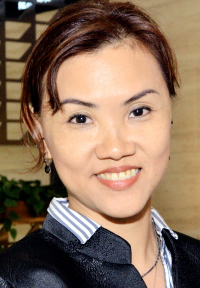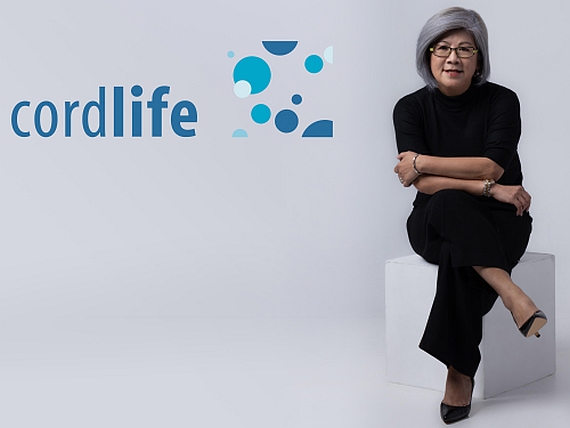 This article by Jennifer Tan originally appeared in SGX's kopi-C: the Company brew series, and is republished with permission
This article by Jennifer Tan originally appeared in SGX's kopi-C: the Company brew series, and is republished with permission
| Growing up with asthma, hospitals and emergency waiting rooms were familiar territory for healthcare industry veteran Tan Poh Lan. “I was horribly asthmatic as a kid, and spent time in hospitals whenever I suffered an attack,” recalled the Group Chief Executive Officer of SGX-listed cord blood banking services company Cordlife Group Ltd. “And because I loved the sciences, particularly biology, I wanted to build a career in healthcare.” In 1985, Tan graduated with Honours in Occupational Therapy from Australia’s University of Queensland. She began her career as an occupational therapist with Singapore General Hospital a year later. “As an occupational therapist, interacting daily with patients who suffered from trauma or disabilities, I learnt to deal with challenges head-on and look for alternative solutions,” she said. “For example, how do you help a handicapped client to cope with daily tasks and routines? There’s always a way, we just have to find it.” |
 Cordlife CEO Tan Poh Lan. Photo: Company
Cordlife CEO Tan Poh Lan. Photo: Company
It helps that Tan is an eternal optimist, steeped in pragmatism. “I was brought up to be a practical person,” she said.
“My mum has this favourite Cantonese proverb – 马死落地行 (ma si luo di xing), which means if the horse you’re riding drops dead, just get down and walk. In other words, find another way.”
And it is this indomitable spirit that defines Tan through her three decade-long career in the private and public healthcare sectors, both in Singapore and the region.
She joined Mount Elizabeth Hospital in 1991 as a Marketing Executive and rose through the ranks to the position of CEO in 2007. Between 2007 and 2015, she held CEO roles in other local and regional hospitals, including Parkway East Hospital – formerly East Shore Hospital, and Gleneagles Hospital in Singapore, as well as Vinmec International Hospital in Hanoi, Vietnam, and Fortis Healthcare Singapore.
Tan, who also holds a Master of Business Administration from the National University of Singapore, was appointed Group Chief Operating Officer of Cordlife in 2016. She was promoted to Group CEO three years later.
Incorporated in 2001 and listed on SGX Mainboard since 2012, Cordlife is a pioneer in private cord blood banking in Asia. It owns the largest network of cord blood banks in the region, with full stem cell banking facilities in the six key markets of Singapore, Hong Kong, Indonesia, India, Malaysia and the Philippines. Through marketing agents, Cordlife extended its presence to Myanmar and Vietnam in 2017, and Bangladesh in 2019.
Market Leadership
Cordlife operates the largest private cord blood banks in Singapore, the Philippines and Indonesia, and is amongst the top three market leaders in India and Malaysia. The Group became the market leader in Hong Kong via the acquisition of Healthbaby Biotech in 2018. Through a Malaysian subsidiary, it also holds an indirect stake in Thailand’s largest private cord blood bank, Thai Stemlife.
Beyond cord blood and cord lining banking, Cordlife offers a comprehensive suite of diagnostic services for the family, including urine-based newborn metabolic screening, non-invasive prenatal testing, paediatric vision screening and family genetic screening services.
All the Group’s facilities are accredited by the American Association of Blood Banks (AABB), the organisation behind the world’s gold standard for cord blood banking. In addition, Cordlife Singapore and Healthbaby Hong Kong are also two of four cord blood banks in Asia, and 10 in the world, to be accredited by both AABB and FACT, which is another world-class accreditation body for cord blood banks.
In the area of clinical diagnostics, Cordlife India, Cordlife Hong Kong and Healthbaby are also accredited by the College of American Pathologists (CAP).
When Tan joined Cordlife, she made it a priority to streamline the Group’s operations. “I believe in first things first, which was to optimise the corporate structure,” she said.
“We brought some previously outsourced functions back into the Group, and facilitated collaboration amongst the different markets, all of which have led to significant cost savings,” she noted. “So, over the past year, although the top line hasn’t grown as much as we would like, our bottom line has improved.”
For the six months ended 30 June 2020, net profit jumped 50.2% year-on-year to S$2.63 million, even as revenue declined 12.7% to S$26.2 million. Net profit margin edged up 4.2 percentage points to 10.0%.
But cost-cutting only goes so far, she admitted. “Prudent expense management is not enough – we need to boost revenues as well.”
As a result, the Group has been ramping up new revenue channels, including its diagnostics and digital healthcare business segments, to complement its core operations.
“Stem cell therapeutics are subject to regulatory oversight in each operating country. We welcome government efforts to set ethical guidelines that will allow our industry to progress cautiously and responsibly, as well as to grow in a healthy manner,” Tan noted.
Cordlife has observed an encouraging trend of better alignment of regulations and guidance for stem cell therapeutics globally. As interest in stem cell therapy intensifies, its banking business will be a primary beneficiary, especially in the domain of cellular therapies and regenerative medicine.
|
“Our various country heads are proactively working to develop an ecosystem with doctors and hospitals in their respective countries to encourage utilisation of stem cells. This includes pre-clinical and clinical studies using such cells.” |
The results from Cordlife’s diagnostics services segment have also been encouraging. Revenue contribution from this segment jumped 68% to S$1.6 million in FY2019 from S$0.9 million the previous year. “Diagnostics is a growth engine for all our markets and is expected to drive our business forward.”
Middle-Class Market
Generating and boosting awareness of the potential of cord blood, cord tissue, as well as cord lining banking is another focus, Tan noted.
Cord blood banking involves the collection at birth, processing, testing, cryopreservation and storage of stem cells from umbilical cord blood. Cord tissue and cord lining banking refer to the collection, processing, testing, cryopreservation and storage of the umbilical cord tissue or lining. The process for cord lining banking uses patented technology from Singapore-based stem cell technology firm CellResearch Corporation via an exclusive license.
Currently, penetration rates in Malaysia, India, the Philippines, Indonesia, Vietnam, Myanmar and Bangladesh remain relatively low - at single digits compared to Singapore’s double-digit rates.
“But we believe there is huge potential for growth in these countries as healthcare spending by the progressive middle and affluent classes is on the rise,” she added. “Once you’re able to capture the attention of mothers-to-be, it’s easier to get their buy-in - it’s usually the women who make healthcare decisions for the family.”
Cordlife is also in the midst of developing its mobile application, Moms Up, which provides health information and resources to help Asian women who plan to conceive or are expecting, as well as mothers with young children. It targets to roll out the app to all its markets by year-end.
“Leveraging on this digital platform, we intend to expand our reach to potential clients and increase touchpoints with existing customers,” she said. “It also serves as a base for us to educate and increase awareness of our services.”
Apart from driving organic growth, Cordlife is also seeking acquisitions to further strengthen its market position, and expand its footprint beyond its current 10 markets in Asia.
“We will review any horizontal integration opportunities to add to the Group’s revenue and earnings growth,” Tan added. “These targets will be synergistic to our existing businesses and provide a competitive edge over other market players.”
In particular, China is one market it has been exploring, with the abolishment of the country’s one-child policy highlighting potential opportunities in its cord blood banking industry.
“In recent years, China has made remarkable advancements in stem cell therapies, bringing fresh insight to regenerative medicines. The strong government support and investment in stem cell research bodes well for our strategy of building the ecosystem of utilisation.”
Last June, Cordlife made an indicative, non-binding proposal for a statutory merger with Global Cord Blood Corporation, the first and largest cord blood bank in China. Negotiations are still in the preliminary stage, she added.
| Digitalisation Drive In the meantime, the 58-year-old has her hands full managing the fallout from the coronavirus pandemic. “COVID-19 has affected demand for the Group’s banking services and tightened consumer spending, resulting in lower client acquisitions,” she admitted. “With some of our key geographical markets facing recurring waves of the outbreak, we expect to face continued uncertainties from COVID-19 in the coming months.” With social distancing measures and border controls restricting Cordlife’s ability to carry out physical promotional activities or deliver services, the Group has embarked on digital initiatives, including online consultations, webinars and e-enrolment to engage potential clients. “To capture potential business opportunities, we continue to ramp up our digital marketing campaigns, which have allowed us to reach out to a larger audience,” she added. Other roadblocks include declining or stagnating birth rates in Cordlife’s target market segments. “It’s a known trend that middle to upper class professionals living in cities are having fewer babies,” Tan said.
“Organisational success is often linked to an inspiring vision, a clear mission and strong values. But do I have the right people? Do I have enough of the right people - not just for Singapore, but also for our other markets?” And in an increasingly interconnected and digital environment, cybersecurity is another issue that looms large. “The growing risks and threats to IT security cannot be ignored. COVID has fast-forwarded our move online, and we need to ensure the safety, security and confidentiality of all our client data.” Despite these day-to-day concerns, Tan retains her sunny optimism. “I choose to believe that there’s always a way out, and a solution can be found for every problem we face.” Not surprisingly, her greatest inspiration is making a positive impact on the people who cross her path. “You can always learn something from each person you come into contact with, no matter how big or small.” “This is what energises me, and keeps me going every day.” |
Cordlife Group Ltd
Cordlife listed on the Mainboard of Singapore Exchange in 2012, and is a pioneer in private cord blood banking in Asia. Established in May 2001, it currently owns the largest network of cord blood banks in Asia, with full stem cell banking facilities in six key markets, namely Singapore, Hong Kong, Indonesia, India, Malaysia and the Philippines. Cordlife operates the largest private cord blood banks in Singapore, the Philippines and Indonesia, and is amongst the top three market leaders in India and Malaysia. In January 2018, Cordlife became the market leader in Hong Kong with the acquisition of the largest private cord blood bank in the country, Healthbaby Biotech. Through its majority-owned subsidiary in Malaysia, Stemlife Bhd, Cordlife holds an indirect stake in Thailand’s largest private cord blood bank, Thai Stemlife. Through marketing agents, Cordlife also expanded its presence to Myanmar and Vietnam in 2017, as well as Bangladesh in 2019. Beyond cord blood and cord lining banking, Cordlife offers a comprehensive suite of diagnostics services for the family, including urine-based newborn metabolic screening, non-invasive prenatal testing, paediatric vision screening and family genetic screening services.
The company website is: www.cordlife.com
Click here for the company's StockFacts page.
For the half year ended 30 June 2020 financial results, click here.
kopi-C is a regular column on the SGX Research website that features C-level executives of leading companies listed on Singapore Exchange. These interviews are profiles of senior management aimed at helping investors better understand the individuals who run these corporations.
For previous editions of kopi-C: the Company brew, please click here.
